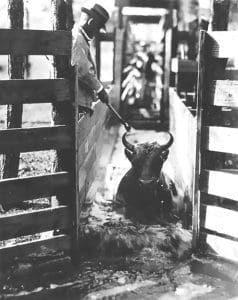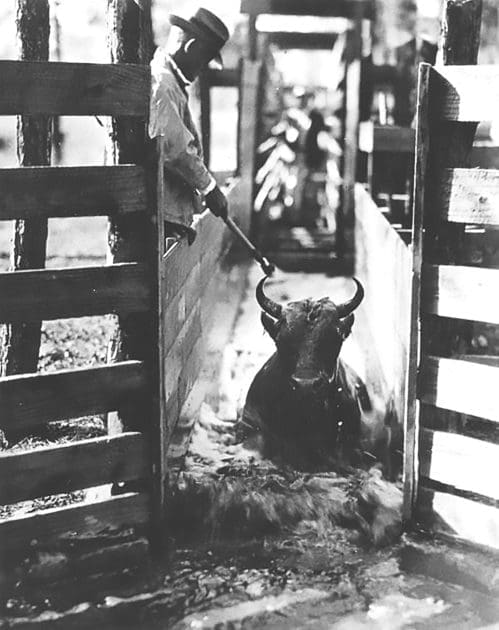
By Patti Wilson Contributing Editor
The long and storied history of our industry would not be complete without taking a dive into the dipping vat of the Texas fever tick. It surprisingly veers from the biological to the political in a way that helped to mold our beef business in the United States. Many thanks go to Texas State Historical Association (TSHA) and Texas A&M University’s AgriLife Extension Service websites.
Treading of Hooves
Although the trailing of cattle was underway in 17th century America, the heyday of the big drives ran from 1866 to 1890.
Post-Civil War Texas was awash in cattle, which had multiplied unsupervised while their owners were away fighting. Numbers swelled to an estimated 6 million head during the conflict. Confederate soldiers returned home to find tough, wiry, feral herds on their properties worth all of $2 each. Some of these bovine outlaws were herded through swamps to New Orleans, while others were driven through deserts and mountains to the gold fields of California. Demand for beef ran far and wide, but the most lucrative markets were north and east, in Yankee territory. Livestock inventory there had been decimated during the Civil War. Some cattle driven east were farmer fed before going to harvest, and many others were sent directly to packing houses in St. Louis, Mo., and Cairo, Ill. Profits were substantial.
Health problems began to arise in the mid-1850s in Kansas and Missouri, prompting their state legislatures to quarantine these states against “southern cattle.” It was a messy business.
Trouble Erupts
Although some southern drovers were successful and profitable in their endeavors, many others encountered hostile and heavily armed farmers. Missouri was an especially dangerous state to travel, with some herds being impounded or even killed. Fines of up to $1,000 were commonly charged. More than a few drovers chose to give up their northern drives, unable to stand up to the scathing anger of the locals. Business had been severely disrupted by a disease no one knew how to control. By this time, at least six states had barred Texas cattle.
Enter a certain Illinois cattle buyer Joseph G. McCoy. He proposed developing a marketplace far from settled areas to gather southern stock. Cattle would be shipped by rail to eastern packing houses, avoiding contact with local livestock. He was especially impressed with Abilene, Kan. It was near the center of the Great Plains, largely uninhabited and surrounded by a sea of grass. McCoy worked diligently to convince the Kansas Pacific Railroad to build sidings and stockyards there, and negotiated a commission for himself for each carload of cattle trailed to the site.
Next, he persuaded the Kansas State Legislature to ignore the state’s quarantine law at Abilene. He lobbied the Illinois Legislature to allow Texas cattle into their state after being “wintered in Kansas” and provided documentation for each herd heading east. By 1867, he had procured 35,000 head. It remained the principal railhead market for Texas cattle until 1873, when a renewed quarantine forced its closure. By that time, more than 1.5 million Texas cattle had been driven to Abilene, Wichita and Ellsworth, Kan.
It is interesting to note that the majority of contract drovers were paid $1 to $1.50 per head delivered to market for their owners. Mostly Texas youth were employed on the trail, former Confederate boys ages 12 to 18. Cooks, horse wranglers and trail bosses were an older and better paid part of the crew.
What Is Texas Cattle Fever?
One of the earliest scientific descriptions of the fever came out in a June 1868 issue of the Veterinarian, an English journal. It noted that a “very subtle and terribly fatal disease had broken out among cattle in Illinois. The disease killed quickly and was reported to be fatal in every instance.” It didn’t take farmers long to figure out it was associated with Texas longhorns.
This problem was percolating during the era of Louis Pasteur, who had discovered pathogens and was wildly successful in diagnostics and vaccine development. Scientists in Texas were paying attention. Finally, in 1893, Theobald Smith and Fred Kilborne, employees of the Bureau of Animal Industry in Washington, D.C., isolated the Texas fever pathogen. It was identified as a microscopic protozoan that inhabits and destroys red blood cells. Today, it is recognized that either of two species of the genus Babesia may be involved in the fever. The duo also discovered the vector, cattle ticks.
This diagnosis has been validated worldwide. It was the first time a disease agent was proven to be transmitted from an infected animal to one uninfected by an intermediary host. According to the TSHA website, “After sucking blood from an infected animal, a tick would drop off into the grass and lay eggs which would hatch young ticks already harboring protozoa. Weeks after the original tick dropped from the Longhorn host, its progeny were still capable of infecting other cattle.”
Getting It Under Control
Another major player in this story is Daniel E. Salmon, DVM, veterinary surgeon, who joined the U.S. Department of Agriculture in 1870. His focus was on investigating animal diseases in southern states. He clearly demonstrated the importance of keeping infected stock apart from non-infected. Salmon also researched the line between where the disease was endemic and where it had not yet spread. It contributed to the development of regulation in interstate movement of livestock.
Treatment methods were next on the table; first came tanks and dipping solutions, which are still available today. The first solution consisted of a mixture of white arsenic, soda and pine tar in a dipping vat. The tick eradication from this method was so successful that a division of the Bureau of Animal Industry (BAI) was dedicated to it in 1917. Cattle were required to take the plunge every 14 days, for six to nine months.
Although dipping is still acceptable, an injection of doramectin every 25 to 28 days for six to nine months is considered more convenient and economical.
Another method is vacating premises for nine months, after which a pasture is free of ticks. The life cycle of a fever tick is three to four weeks. Up to four generations may be hatched each year, and a single female is capable of laying up to 4,000 eggs, then dies.
Symptoms
Ticks are most often found on the dewlap, and from elbow to stifle. Inside the hind legs is a popular hiding spot, as well. Heavy infestations may produce ticks everywhere.
Symptoms include anemia, rapid breathing, weight loss, decreased milk production and 70 to 90 percent death loss.
Today
Texas fever is endemic in Mexico. More than half a million border acres have been designated as a Permanent Fever Tick Buffer Zone. Occasional outbreaks still happen in this area.
Texas fever has been on the proverbial “uptick” in the United States since 2015. The southern United States is home to more than 400,000 cattle operations. According to Texas A&M’s AgriLife website, the area produces “a third of all fed cattle in the country. There are no protective vaccines and no approved drugs to treat sick animals in the U.S. Cattle industry losses across the southern United States today would be about $1 billion annually.”
It’s a good idea to steer clear of the tick.







